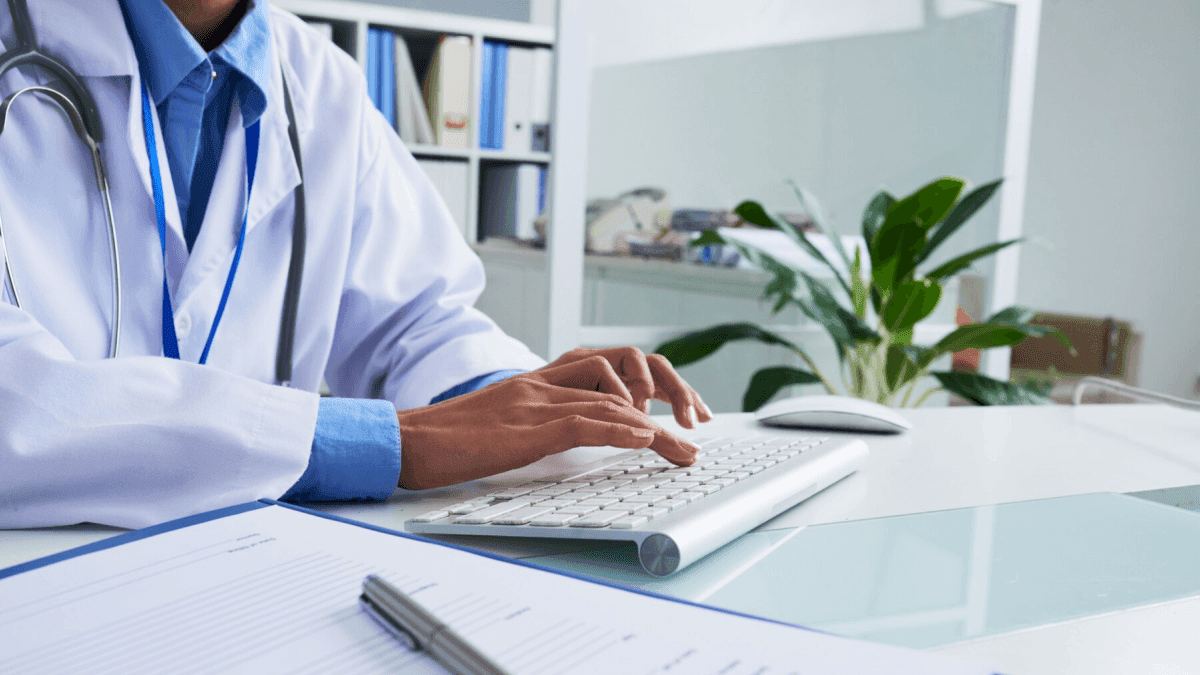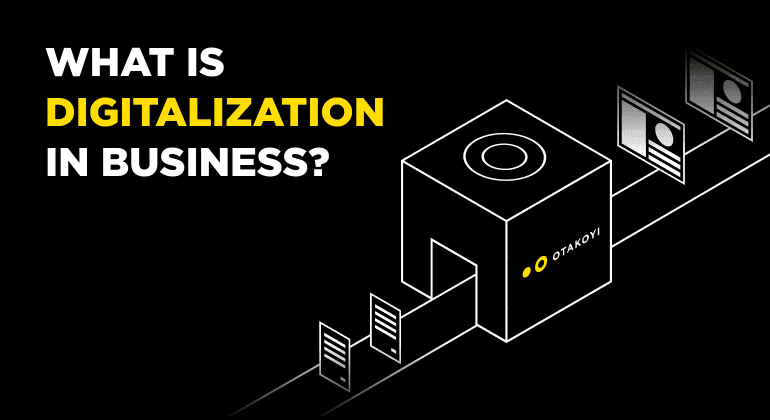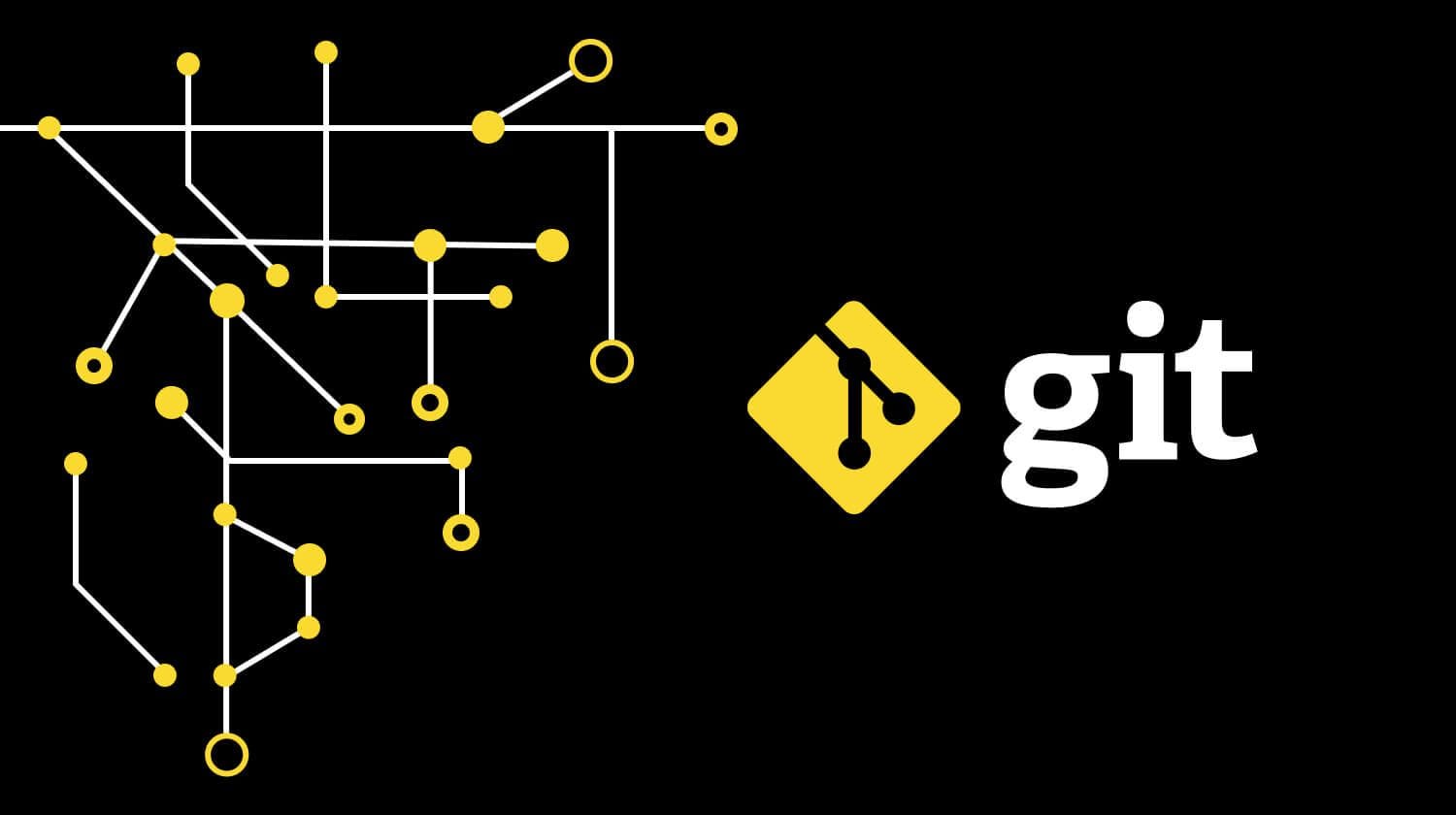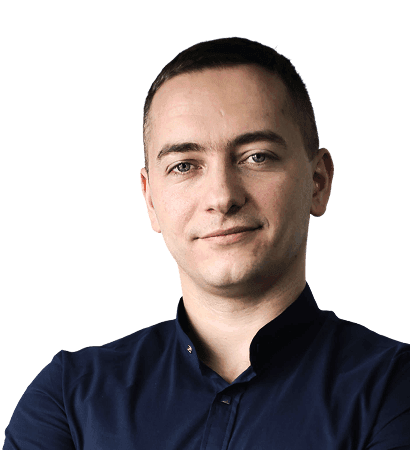Patient Management Software: A Comprehensive Guide to Features and Benefits
When you are taking care of a patient, what comes to mind first? Physicians concur that providing prompt, efficient care should come first, but it's better still if it's something you can catch early on and treat.
However, doing these tasks by hand is tiresome. Particularly if you're overflowing with paperwork and reports. That is why technology is being quickly used by healthcare companies in order to better manage tasks of patient management. One such tool you need to increase the effectiveness of your healthcare practice is patient management software.
However, let's first define patient management software before discussing any advantages or features.
Defining Patient Management Software
Patient management software, or PMS, is an instrument for handling administrative duties and keeping track of patient information. To be clear, this covers a variety of things, such as patient diagnoses, billing details, and appointment scheduling. The system may handle patient information delivery and management through the use of patient management software.
Physicians and staff can prioritize developing trusted patient relationships. Prior to the use of patient management software, obtaining the patient's prior treatment report was a laborious and time-consuming procedure. You are only a click away from anything. Therefore, hospitals are essentially changing the game with the patient management system.

Want To Elevate Your Healthcare Organization With This Top-Notch Solution?
Contact usWhat Challenges Do Healthcare Professionals Encounter?
Patients of today need prompt, high-tech, and personalized care that is also efficient. Doctors and other medical professionals would want to pay more attention to patient care rather than paperwork and reports.
The most frequent difficulties they encounter as a result of not having a PMS are the following:
- High healthcare costs, irregular visits, and ineffective procedures.
- Many manually recorded patient data records.
- Insufficient and untrustworthy patient medical history documentation.
- Inability to exchange data between departments or locations.
- Rarely are therapy modifications promptly conveyed.
- The payment procedures might be convoluted and include multiple insurance providers.
- Long wait times and ineffective care impair the patient experience.
In terms of healthcare, this is only the tip of the iceberg. Patients now expect more from physicians and the healthcare industry in the interim. Potential clients look up providers on Google before selecting one. For example, when choosing a physician or other professional, 94% of patients check online reviews. As a result, having an internet presence is now essential, although practically all providers have websites.
Patient happiness is the single factor that sets everything apart. What, then, can you do to live up to these standards? Put in place a system for managing patients! Moreover, a survey showed the undeniable success of the software, as 89% of physicians and healthcare organizations have already established patient management solutions (as of 2020). So this is definitely food for thought!
Exploring Patient Management Software Key Features
Your team is frequently too preoccupied with patients to spare more time and resources for administrative tasks. Patient management software, fortunately, can be helpful. In light of this, take a look at some of the primary benefits it provides to a variety of medical specialists, including family doctors, dentists, and optometrists. 
1. Medical billing
Although it is an inevitable aspect of the healthcare industry, nobody likes discussing money. The burden of invoicing is lessened by the billing functions of patient management systems. Furthermore, research projects that between 2020 and 2027, the CAGR for medical billing software will increase at a rate of 5.1%.
This PMS function maintains track of all past and current payment information. Additionally, when a patient checks in, it verifies their insurance eligibility and keeps track of their prescription information.
The revenue cycle following contacts, prescriptions, treatments, or other services is automated by patient management software. The goal is to standardize the income received and the bills for each patient. Certain sophisticated systems even permit the purchase of prescription drugs from network pharmacies. When payments are due, the software automatically sends out reminders.
A patient management system, to put it briefly:
- monitors the progress of claims;
- oversees patient accounts;
- streamlines and automates the billing process;
- reminds payments;
- enables online purchasing.
The patient management system's payments module also has the advantage of automatically sending reminders by email, WhatsApp, SMS, and other channels. As a result, you won't need to regularly monitor accounts and remind patients to make payments.
2. Appointment scheduling
One unavoidable component of any in-person encounter is setting appointments. According to recent studies, 48% of patients say that scheduling an appointment over the phone is their preference. On the other hand, 43% would rather make appointments online. And each year, this figure rises.
You may make sure that you efficiently schedule any upcoming visits by utilizing a hospital patient management system. It has the ability to monitor and capture data from multiple sources, enabling you to contact patients again and lowering the number of no-shows. Additionally, it makes it easier for patients to schedule appointments. Online appointment scheduling is available for patients to check the doctor's availability as well.
3. Health network
Such a network is a great tool to improve care and gather insightful data and strong analytics on a range of patient demographics. To improve diagnosis, you can obtain reports on population risk, care coordination, and other topics.
Hospitals, clinics, and other establishments must live up to the expectations of healthcare consumers. Most people anticipate receiving great, individualized care from medical experts.
What do they desire from their health providers?
- Showing empathy;
- Recognizing their needs and requirements;
- Talking rapidly;
Facilitating convenient access to patient records and all the necessary data.
4. Patient portal
The primary usage of a patient portal is for external patients. It is the most crucial component of any software for patient management. The patient can gather information and update their documents with the aid of the patient portal. Patients can contact doctors and pay bills with this service as well.
These procedures reduce the amount of time needed for in-person documentation completion while also expediting a patient's initial clinic or hospital visit. When they arrive, patients will check in online, and the system will record their wait times. Information on the patient's wait time serves as a benchmark for performance reviews.
5. Automatic reminder system
Are you tired of chasing down unpaid bills or patients who never show up? In that case, we have great news for you! Patients are informed of their next appointments using patient management software. In the event that a payment is not collected after the visit, the system will record the payment processes and send payment as well as appointment reminders when it is due.
6. Revenue cycle management
It helps you to keep track of expenses and invoices and to permit online payments. Allowing patients to make payment plans will make the process easier for them.
Although it is an inevitable aspect of the healthcare sector, nobody likes discussing money. The patient management system also simplifies the billing procedures. This PMS function maintains track of all past and current payment information. Additionally, when a patient checks in, it verifies their status in their insurance company and keeps track of their prescription information.
The goal is to standardize the income received and the bills for each patient. Certain sophisticated systems even permit the purchase of prescription drugs from network pharmacies.
Patient Management System - The Key Benefits It Brings
Thus, in the future, should someone ask you, for example, what patient management software is? Now that you are aware of the solution, let's explore the advantages of utilizing a patient management system. Let's examine the advantages that your hospital or medical organization can attain using PMS, starting with the evident benefits of patient management software for patients.
Your healthcare business can decrease expenses by automating operations, eliminating unnecessary or redundant stages, and even eliminating prevention-related downtime or lawsuits when you utilize an efficient patient management software application. Let's take a closer look at each of those advantages.
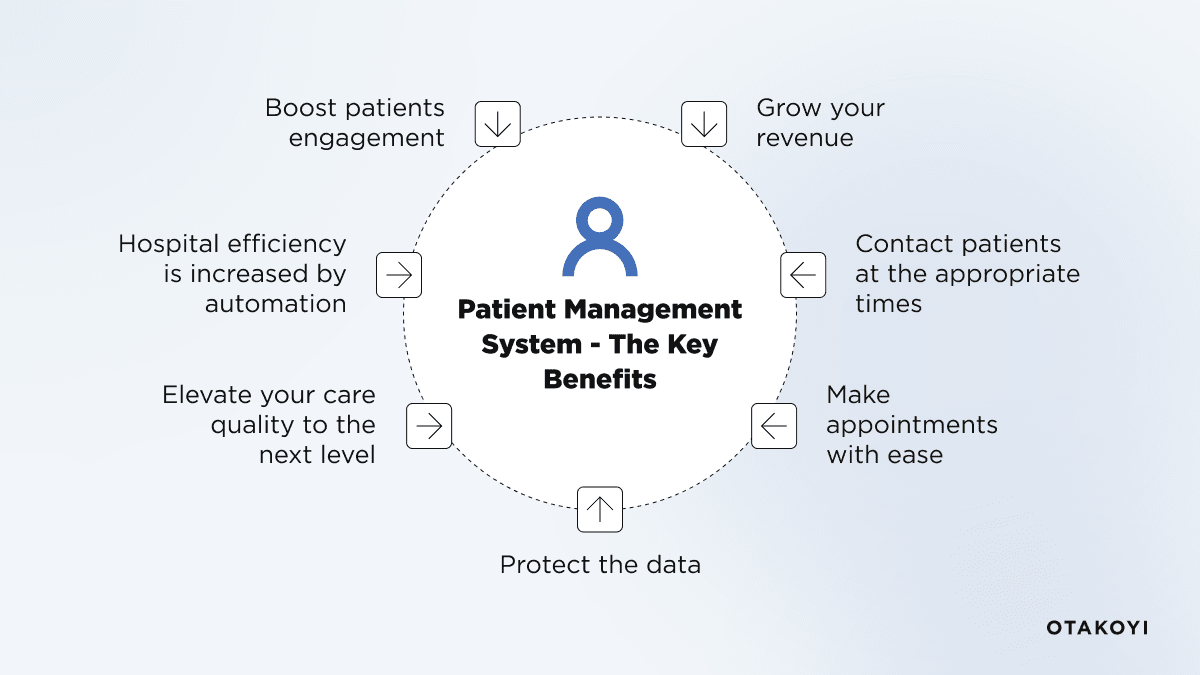
1. Boost patients engagement
Most doctors believe that a company's main objective should be patient engagement. Maintaining patient engagement enhances health, boosts satisfaction, and fosters a sense of loyalty among patients and healthcare professionals, as well as medical institutions.
Active patients are devoting more time and effort to their well-being, producing more encouraging outcomes and assisting healthcare organizations in reducing expenses and resource usage. You can be in touch with your patients on a large scale and reap the benefits of using automated patient engagement tactics.
Most significantly, the patient management system will help doctors make better medical decisions and feel more confident about their treatment plan, all of which will save significant time later on both the patient and the hospital.
2. Contact patients at the appropriate times
Today's patients have higher expectations of healthcare providers. They want the guarantee that their physicians and nurses will be there for them, as well as excellent, whole-person supervision.
Waiting rooms may be excruciating and distressing for patients. Even though it makes up a minor portion of patient encounters, wait times have a lasting impact on patient satisfaction.
When healthcare institutions are unable to provide adequate and quality patient care or effectively manage patient flow, they suffer from increased expenditures. Patients may have to wait for hours on end, experience tension, and feel uncomfortable. Patients may simply schedule appointments through the patient portal, thanks to patient management software.
Your front desk staff does not need to put in any extra effort to keep track of cancellations and reschedulings. Updates are occasionally sent to you via phone, text, or email.
3. Hospital efficiency is increased by automation
Old documentation and procedures might make patient care more difficult. It's high time we decrease our reliance on human resources. According to predictions, the global market for medical automation will grow from USD 44,864.14 million in 2020 to USD 93,734.64 million in 2028.
Medical staff can concentrate on providing patient care instead of handling numerous administrative chores that can be automated and standardized. Employees may perceive the benefits of this advancement and find their work to be more satisfying as a result. Patients also benefit from a higher degree of value-based medical care when staff members are content and healthy.
With the aid of patient management software, healthcare professionals are turning data-handling activities into true innovation in addition to automating to save costs and increase working productivity.
4. Elevate your care quality to the next level
Trust is the foundation of good patient care. By facilitating rapid access to patient information and treatment records, the patient management system contributes to improved quality and effective treatment. Requests for follow-up appointments and treatment plans are more likely to pique the interest of patients who feel seen and cared for.
The effectiveness of patient management software, staff competency, infrastructure quality, and training quality all affect the standard of patient care.
Treatment errors caused by incomplete or inaccurate paper records are eliminated, patient workflow is enhanced, and immediate record transfers are made possible by a comprehensive management program such as a hospital management system.
5. Significant growth in revenue
When someone has a wonderful experience, they want to tell other people about it. Word-of-mouth marketing and patient loyalty are efficient strategies for your hospital to make money. However, can expenses be reduced while improving the patient experience? Ultimately, wouldn't such an endeavor necessitate greater funding?
It is true that you must make investments in enhancing the systems that directly affect patient convenience in order to give a more convenient experience. The most extraordinary remedy for that is the hospital patient management software.
6. Make appointments with ease
One unavoidable component of any in-person encounter is setting appointments. Having online communication channels is crucial for your patient management system. Reduced patient acquisition may also occur from their non-implementation.
You may make sure that you efficiently schedule any upcoming visits by utilizing a patient management system. It has the ability to monitor and capture data from multiple sources. Additionally, it makes it easier for patients to schedule appointments.
7. Protect the data - comply with a PMS to guard the data
One of the most important factors that determine a medical facility's overall reputation and trustworthiness is patient data security. Therefore, protecting your data comes first.
Experts have emphasized and reaffirmed the need for hospitals using manual systems to be more resilient to data breaches and theft than those using automated ones. With fully functional patient management software, all data is kept safe from unwanted access. Furthermore, the software ensures that access is restricted to those who are permitted.
What Is the Cost of Patient Management Software?
The cost will mostly rely on the patient management software features, support, and customization needed, just like with most software programs. After that, you can discuss any offers with your software developer. The system's price depends on patient management process development and can vary significantly depending on several variables. Let us provide you with some details.
#1 Basic software
For a small clinic or medical practice, entry-level patient management software may start at about $200 to $500 per month. Typically, these systems provide basic functions like billing, scheduling appointments, and managing patient records.
#2 Mid-range software
You should estimate your budget between $500 and $1,500 monthly for more complete patient management software solutions with extra capabilities like electronic health records (EHR) or electronic medical records (EMR), medical billing, and patient portals. These mid-range systems frequently serve specialty offices or larger clinics.
#3 Enterprise solutions
To meet their complicated needs, large hospitals or healthcare networks may need software solutions that are reliable and adaptable. The monthly cost of these enterprise-level systems might range from $1,500 to $5,000 or more, depending on the extent and size of the customization needed.
#4 One-time costs
Depending on the features and scalability, some software suppliers allow you to buy the program outright for a one-time license price. This cost may range from a few thousand to tens of thousands of dollars.
#5 Extra expenditures
It's essential to account for extra expenditures, including those associated with implementation, training, continuing maintenance and support, and any prospective integrations or add-ons with other software programs.
OTAKOYI – Your Dedicated Software Partner for Building Patient Management Software
You may start wondering how you should choose the best software partner for your healthcare facility. Let us provide you with the main advantages of cooperating with Otakoyi company for healthcare software development services, including the creation of powerful patient management software.
- We provide complete customization for this software so that you can adapt it to your hospital's needs.
- You benefit from distinct patient, nurse, and doctor interfaces
- We offer secure and advanced cloud-based software for patient management.
- You get to choose multiple functions, including online scheduling and a lot more.
- We also give full-cycle services so you get your software maintenance and may plan software scalability with us.
As a famous quote says, “Actions speak louder than words.” So, the best way to see all the benefits of working with us is to invite you to discover solutions like Medidoc and PeteHealth developed by our team.
Final Words
Patient management software has changed the delivery of care. It allows medical professionals to concentrate more on patient interaction by centralizing data, streamlining administrative procedures, and saving time and money. In summary, it improves patient outcomes, shortens wait times, and maximizes operational efficiency.
You can accomplish all of these goals with the Otakoyi team. It is the best decision to save time for yourself and your staff. Set up a demo right now to find out more!
